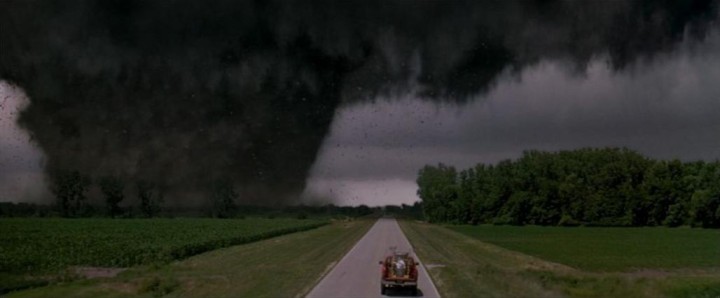‘Twisters’ (2024): How Will This Standalone Sequel Compare to the Classic Original?
With the highly anticipated film Twisters set to release on July 19th, 2024, fans wonder what to expect and how it will differ from the original 1996 classic Twister. Described as a standalone sequel, the new film won’t have any of the same characters and won’t be following the same plot. It will, however, still follow a team of storm-chasers and will likely include a few nods to the original.
But will the two movies really be all that different? Below, we’ll analyze what makes each film unique. But first, let’s look into each individual film.

Twister (1996)
Twister is a thrilling disaster film directed by Jan de Bont. The story follows storm chasers played by Helen Hunt (as Dr. Jo Harding) and Bill Paxton (as Bill Harding), as they pursue the most powerful tornadoes to test a groundbreaking weather alert system. Alongside its gripping narrative, Twister is renowned for its groundbreaking special effects that bring the fury of tornadoes to life. Audiences were captivated by the film’s lifelike depiction of tornadoes, a feat rarely accomplished with such realism before. The combination of cutting-edge CGI, practical effects, and sound design created an immersive experience that drew viewers into the heart of the storm.
This original classic includes many other famous actors, including Cary Elwes, Philip Seymour Hoffman, Jami Gertz, and Lois Smith. It was also nominated for two Academy Awards: Best Sound and Best Visual Effects.

Twisters (2024)
Twisters is an action-packed thriller that follows the story of a group of storm chasers documenting an unprecedented outbreak of tornadoes. Directed by Lee Isaac Chung, the film blends heart-pounding special effects with emotional depth as characters confront both natural disasters and personal demons. With a stellar cast, including Daisy Edgar-Jones (who plays Kate Carter) and Glen Powell (who plays Tyler Owens), Twisters promises breathtaking visual sequences and a gripping narrative. Its focus on human resilience and the destructive beauty of nature offers a compelling cinematic experience that will bring audiences to the edge of their seats.
Twister (1996) vs. Twisters (2024)
Several key differences set the two films apart. Firstly, Twisters leverages contemporary advancements in CGI and special effects to deliver more visually stunning storm sequences. The depiction of tornadoes in Twisters is more realistic and intense, benefiting from two decades of technological progress in film production.
In terms of narrative, Twisters introduces a new generation of storm chasers, diversifying its cast and broadening the story’s emotional and personal stakes. While Twister centered on the storm chasers’ pursuit of scientific understanding, Twisters dives deeper into the characters’ backstories and motivations, adding layers of relational drama and personal conflict. This sequel pays homage to the original’s scientific spirit and expands on the human elements, depicting how the legacy of storm chasing impacts the new characters.
The themes in Twisters also adapt to contemporary concerns about climate change and extreme weather, expanding its scope to address global environmental issues. Unlike the 1996 film, where tornadoes were primarily natural phenomena, Twisters contextualizes these events within larger discussions about human impact on the environment. This shift not only makes the story more relevant to modern audiences but also offers an educational component, highlighting the importance of environmental responsibility and resilience.
The 2024 sequel stands out in its directorial vision. Director Chung brings a unique aesthetic quality, infusing the thrilling action sequences with a more contemplative and immersive atmosphere. This contrasts with Jan de Bont’s more straightforward action-driven approach in the original Twister. Chung’s narrative style emphasizes the characters’ emotional experiences as they confront their pasts and futures amidst the chaos of catastrophic weather, adding psychological depth to the action-packed plot.

Furthermore, Twisters places a stronger emphasis on technological advancements in storm-chasing equipment and forecasting techniques. The gadgets and tools used by the storm chasers reflect the real-world evolution of meteorological science, showcasing state-of-the-art drones, sophisticated radar systems, and advanced computer models. These elements enhance the realism and excitement of the chase scenes and underline the progress made in tornado research since 1996.
Twisters modifies its tone and pacing to fit modern cinematic tastes, employing a tighter narrative structure with more complex character arcs. The dialogue is sharper, and the stakes feel higher, partly due to the more immersive sound design and score, which intensify the emotional and sensory experience of watching the film.
In Conclusion
While Twisters remains faithful to the essence of the 1996 film Twister by delivering high-stakes storm chasing and spectacular action sequences, it distinguishes itself through advanced visual effects, a richer narrative focus, relevant contemporary themes, a distinctive directorial style, and an updated portrayal of meteorological science. These elements collectively contribute to a movie that forges its own path (without forgetting or dishonoring the original) in the disaster film genre.
Are you excited to see the up-and-coming reimagining? Be sure to get tickets to see Twisters, in theaters on July 19th!




